Small-ScaleDairy Farming Manual |
Volume 3 |
|
|
|
|
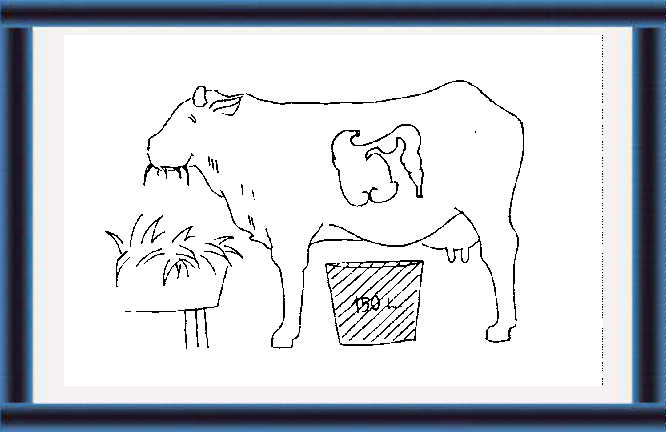 |
|
|
What should you know about feeding dairy cattle and buffalo?
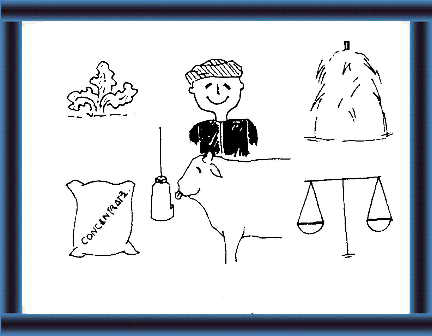 |
What is important in feeding dairy cattle
and buffalo? (5-16)
1 Feeding the right amounts
of:
|
 |
How do dairy cattle and buffalo digest feeds?
(17-28)
2 By having a special stomach with 4 parts. |
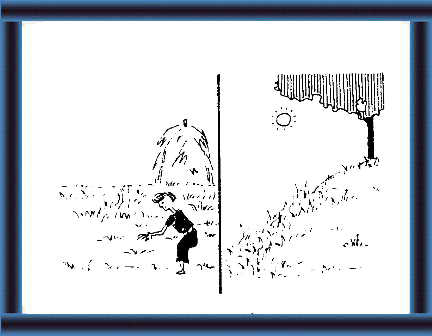 |
What type of feeds are there and what is their
value? (29-51)
3 There are:
|
 |
How much feed do dairy cattle and buffalo
need? (52-91)
4 This depends on:
|
page 3
| FEEDING
DAIRY CATTLE & BUFFALO
Husbandry Unit 4: Technical Notes Note: Numbers in brackets refer to illustrations in the Extension Materials. Introduction (5-8) There are large cattle and buffalo populations in the Asian region. In most countries the indigenous stock is mainly used for draught and meat. However, in India and Pakistan some indigenous breeds have been selectively bred for improved milk production. In most of the countries in the region, programmes have been undertaken for the crossbreeding and upgrading of the indigenous cattle with temperate breeds to obtain higher milk production. Some countries have resorted to large scale importation of pure-bred temperate cattle for the same purpose. It is observed, however, that adequate attention is not being given to proper feeding of dairy animals. Thus they are not producing what they could (i.e. the full genetic potential for milk production is not expressed). This is shown by the higher levels of production in well managed herds than in poorly managed herds with the same type of animals. Adequate attention, therefore, should be given to the proper feeding of dairy animals to obtain best results. |
What is important in feeding dairy cattle and buffalo?
5 For high milk production good feeding must go together with good breeding.
6 Even a good temperate breed e.g. Friesian gives low milk production with poor feeding
7 whereas crossbreeds or selected local breeds can give good milk production with good feeding.
8 Good feeding gives you more milk which you can sell for more money.
| Nutrients
from feeds (9-16)
Dairy cattle and buffalo, like humans and all other animals, need food to obtain the various nutrient requirements for their proper functioning. (The roles played by the combined action of the various nutrients are too complex to be discussed in detail. Only important practical aspects are considered here to make the farmers aware of their importance.) The nutrient requirements can be thought of in a simplified manner as follows. - Bones, which give the body its structure, provide attachment points for the muscles and make it possible for easy move-ment from place to place, are made of minerals. (Minerals are also required in certain varying amounts for proper functioning of the body.) - Muscles, which make it possible for one organ to move rela-tive to others and for the animal to move from one place to another, are made mainly of proteins. (Proteins can also be used as a source of energy, but the main requirement is for body building and repair functions.) - Energy, which is necessary for the various body functions (energy for running an engine is obtained from the fuel that it burns) comes mainly from: - Carbohydrates - Fats. (These are stores of energy and also form part of the connective tissue which bind organs together.) - Activation of various metabolic activities in the body require the presence of vitamins. These are required in minute quantities and may be compared to the lubricating oils in an engine. Whereas animals require these nutrients in a ready made form which can be digested and utilized by them, plants can manufacture these nutrients from air, water and soil nutrients with energy from the sun. |
page 6
 |
9 Your animals need nutrients from feeds to be strong and healthy. |
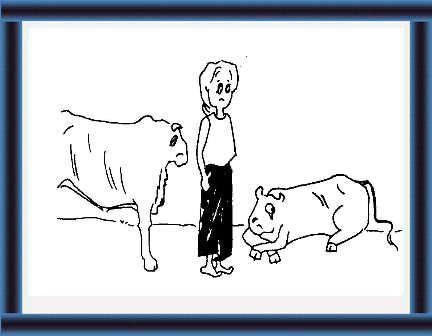 |
10 If some nutrients are
missing
your
animals:
- become weak and get disease - produce less - may not become pregnant. |
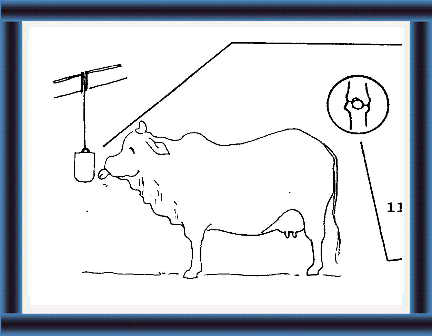 |
11 Your animals need minerals for strong bones and joints |
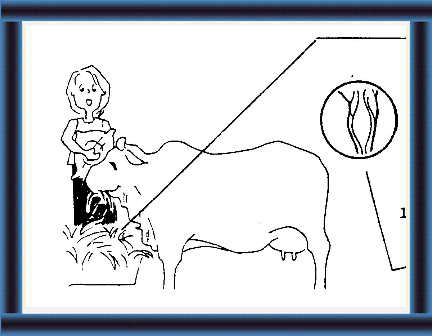 |
12 and proteins to build
strong muscles.
|
page 7
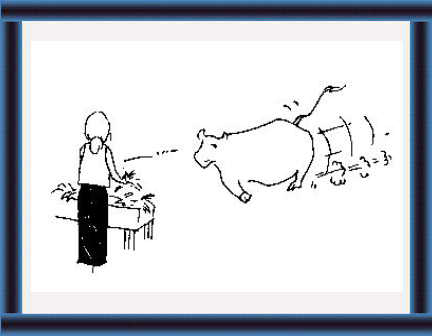 |
13 They need carbohydrates and fat for energy |
 |
14 and vitamins so their bodies can work properly. |
 |
15 Plants can make these nutrients from the air, soil, water and with energy from the sun. |
 |
16 Animals cannot make nutrients, unless you feed the right amounts of the correct feeds. |
page 8
| The
Ruminants (17-28)
Cattle and buffalo belong to the group of animals referred to as ruminants. These animals have a "complex" stomach comprising four different compartments, which enable them to utilize various roughages efficiently and to obtain nutrients from them. The four compartments are rumen, reticulum, omasum and abomasum. The abomasum is the true stomach and is comparable to the "simple" stomach of the non-ruminants. The other three are the "fore" stomachs. At birth the calf resembles a non-ruminant because the "fore" stomachs are not developed. Thus the calf requires milk or milk replacers and calf starters in its early days of life. During this early period, milk gets directed into the abomasum, without passing through the "fore" stomachs, by a special mechanism. As the calf grows it starts to nibble grass (or hay offered to it) and the "fore" stomachs become functional rapidly. Thereafter, the food taken by the animal first enters the rumen. Here the digestive process starts (before reaching the abomasum). The capacity of the "fore" stomachs is about 13-14 times that of the abomasum. In adult cattle/buffalo, the rumen alone may have a capacity of up to 150 litres. Thus they can consume very large quantities of roughages. Within the rumen are billions of micro-organisms, both bacteria and protozoa. These micro-organisms initiate the process of digestion by: - converting the carbohydrates (e.g. sugars, starches, cellu-lose etc) to volatile fatty acids (VFA); - breaking down the proteins into amino acids and even further into ammonia, carbon dioxide and VFA; and - forming new amino acids (including the "essential" amino acids) and more proteins by multiplying themselves. (The bodies of the micro-organisms contain proteins; more pro-teins are formed when they multiply; the proteins are made of amino acids - both essential and non-essential.) The micro-organisms also produce (synthesize) vitamins of the "B" group, which are absorbed and utilized by rumi-nants.) |
page 9
How do dairy cattle and buffalo digest feeds?
 |
17 Cattle and buffalo are called "ruminants" |
 |
18 because their stomach has 4 parts.
With this complex stomach, they can get nutrients from roughages. |
 |
19 The abomasum is the "real" stomach and is similar to your stomach. |
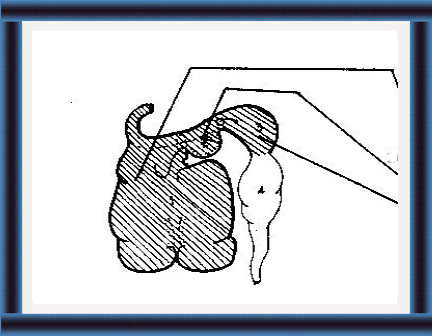 |
20 The other 3 stomachs
- rumen - reticulum - omasum are the "fore" stomachs.
|
page 10
|
The most important features of the ruminant digestive process are: - the ease with which roughages are converted into VFA, which are then absorbed and utilized by the animals as a source of energy (and production of fat); and - the formation of essential amino acids (or proteins contain-ing them, which are broken down into the respective amino acids in the abomasum) from non-protein nitrogen sources e.g. urea and proteins which do not contain any essential amino acids. The amino acids are subsequently absorbed and utilized to form proteins or as a source of energy. Therefore, to make dairying economical, feed buffalo and cattle appropriate quantities of: - roughages
|
page 11
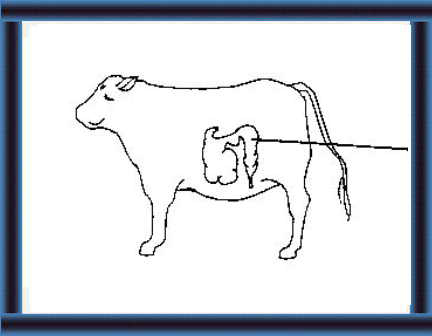 |
21 At birth, your calf has a
stomach like yours.
The "fore" stomachs are not developed. |
 |
22 So your calf needs milk and
milk
replacers.
They go straight to the abomasum without entering the "fore" stomachs. |
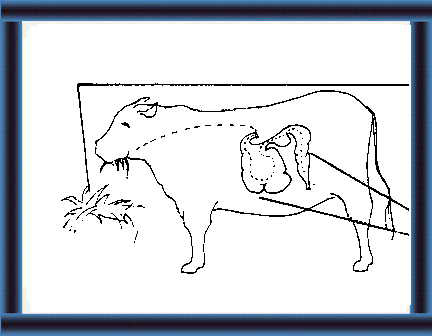 |
23 As your calf grows, it feeds on grass and
hay.
The food enters the "fore" stomachs before passing to the abomasum. |
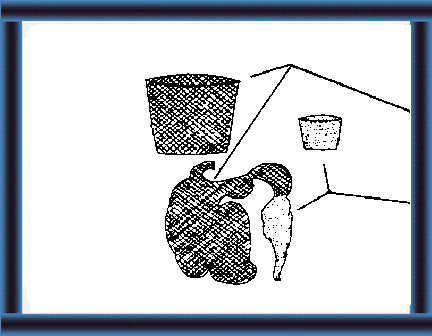 |
24 The "fore" stomachs can hold
13-14
times as much as the abomasum.
|
page 12
 |
25 The "fore" stomachs of your adult animals
can hold up to 150 l.
They can consume large amounts of roughages. |
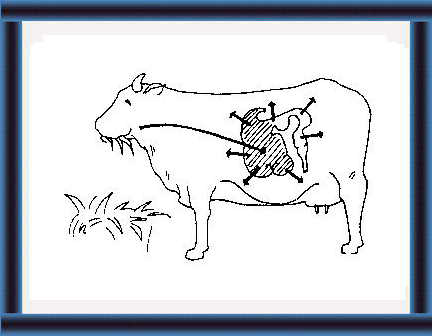 |
26 The rumen contains a great number of micro-organisms which help to change roughages into useful nutrients. |
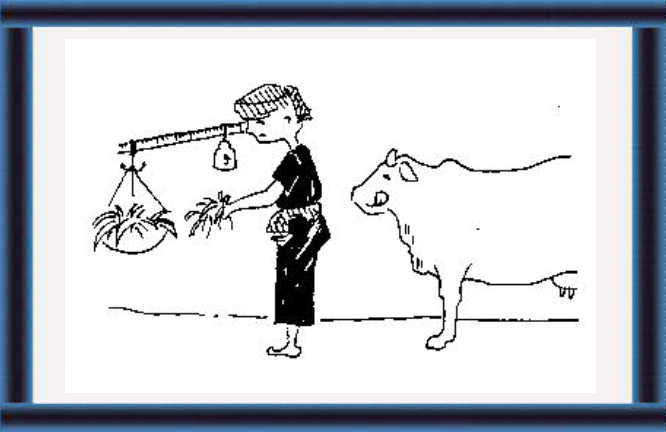 |
27 To save money but
still have good milk production, feed the right amounts of
- roughages |
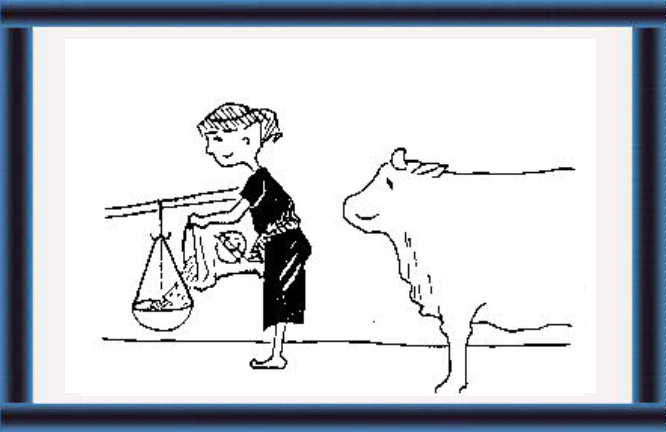 |
28
- protein supplements (with poor quality proteins) - feeds with non-protein nitrogen.
|
page 13
| Types
of feed (for ruminant feeding)
(29-40)
A simple way of classifying feeds is to group them as roughages, concentrates and mineral supplements. - Roughages are feeds with a high fibre content. These include grasses, fodders and legumes - either in the fresh state or in preserved forms such as hay or silage; leaves of trees (tree fodders) and crop residues (see H.1), which can be fed as they are or after treatment to improve the nutritive value e.g. urea treated straw (see H. 5.4). - Concentrates are characterized by a higher dry matter content and a higher digestibility. They can be of plant origin or animal origin. Some of them contain significant amounts of one or more minerals. Mineral supplements are usually available in the form of powders to be offered with the concentrates and in the form of blocks to be offered as licks. They contain varying combinations of minerals. An ideal mineral supplement should supply the shortfall between the animals needs and what is available in the feed it receives. |
page 14
What types of ruminant feed are there?
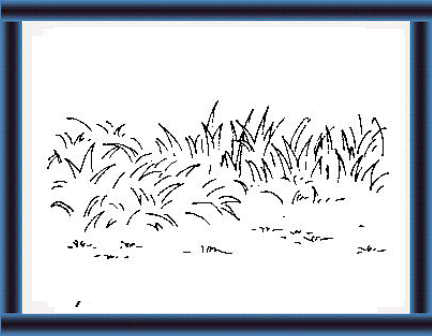 |
29 There are three main
types of feed.
Roughages
|
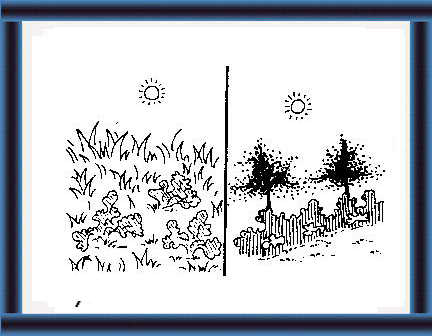 |
30 They include:
- grasses - fodders - legumes either fresh |
 |
31 or preserved as
- hay (See H. 5.3) - silage (See H. 5.4) |
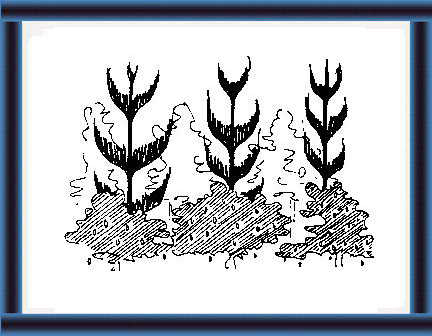 |
32
|
page 15
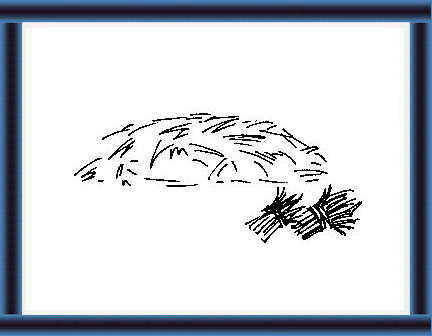 |
33 or treated to improve the nutrient value e.g. urea treated straw (See H. 5.5). |
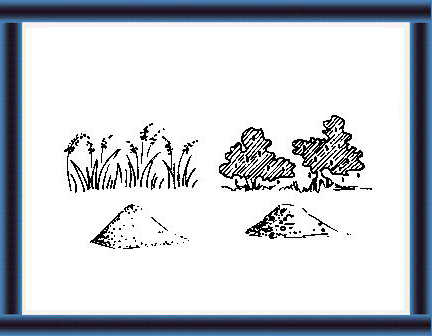 |
Concentrates
34 Concentrates are feeds with a higher dry matter content and a higher digestibility. Plant concentrates
|
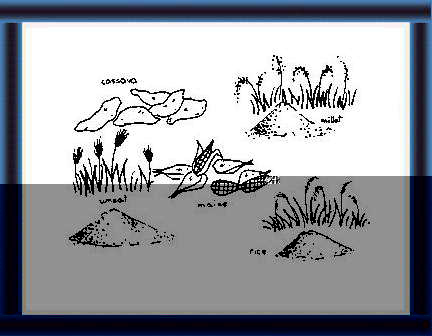 |
35 Energy-rich concentrates
These include: - dried cassava tubers - cereals e.g. rice, wheat, maize, millet, sorghum - agricultural by-products e.g. rice bran, wheat bran, molasses. |
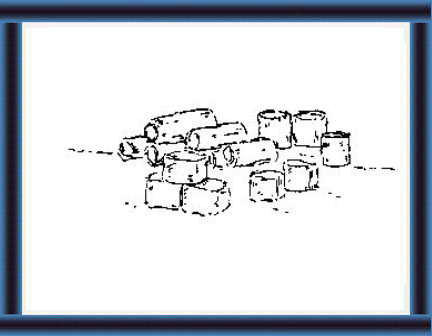 |
36 Protein-rich concentrates
These include residues after you remove oil from vegetable products e.g. cakes or meals.
|
page 16
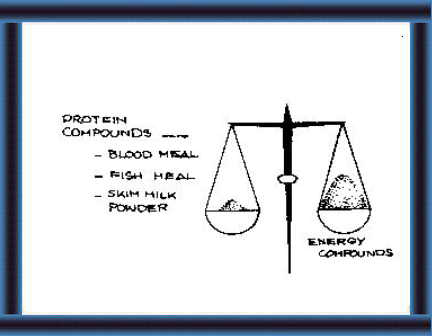 |
Animal concentrates
37 Concentrates which come from animals have more high-quality proteins. |
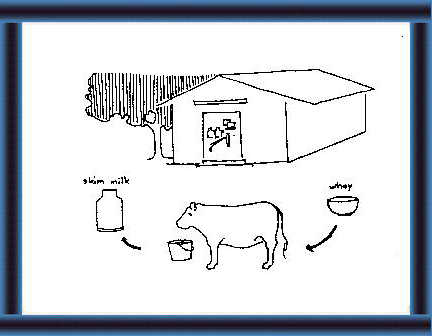 |
38 They include by-products from milk processing
e.g.
- skim milk - whey for calf feeds. These are too expensive for adult animals. |
 |
40 A good mineral supplement should
make up
for
the shortfall of minerals in feeds.
Consult your extension worker about this.
|
page 17
| Feed
quality
The value of a feed depends on: - How much of the intended product (e.g. milk, work, meat) is produced with a unit quantity of the feed. - How much of it will be consumed by an animal (feed intake). It is not easy, however, to establish such a relationship because the final outcome depends on a combination of feeds and many other factors (e.g. the animal's potential for production, the environment, management practices etc.). A simpler way to evaluate the quality of a feed is to determine the quantity of nutrients that can be digested and absorbed from a given quantity of the feed. Even this is not easy to carry out, because it involves: - analysis of a sample of the feed in a laboratory to determine its composition, and - tests to determine the digestibility of each component. However, in most countries, data is already available on the nutritive value of at least the more important feedstuffs. It is very important to remember that the nutritive value of any particular feedstuff can vary, depending on a large number of factors. Some examples are: - the same grass grown in different locations may have differ-ent nutritive values depending on: - climatic conditions and season e.g. rainfall, environmental temperatures, elevation above sea-level etc; - soil fertility and fertilizer application; - stage of growth etc. - hay or silage made from the same plot of grass may have different nutritive values depending on the process of hay making, ensiling etc; - rice bran from different mills or from the same mill at different times may have different nutritive values. Therefore, the extension officer should be aware of the different feedstuffs available to the farmers in his area, and consult the appropriate research institute or authority to obtain information on the nutritive values of these feedstuffs. |
page 18
How can you find the value of feeds?
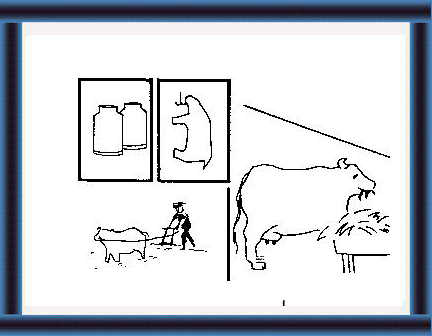 |
41 The value of a feed is
- what your animal produces (e.g. milk,
meat, work)
- what your animal eats (feed intake). |
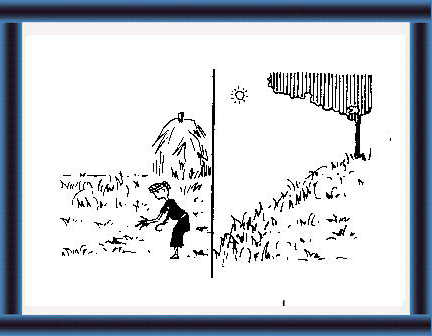 |
42 The value of feeds depends
on
many factors:
- type of feedstuff and variety of plant
|
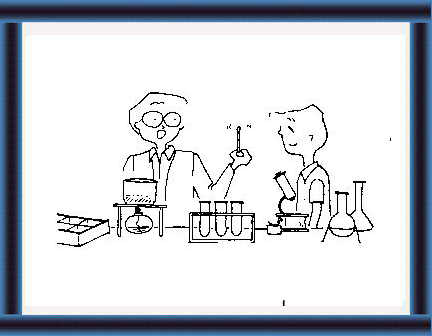 |
43 Laboratory analysis gives the value of feed.
After a lot of laboratory analysis, estimates of feed value are usually available. |
 |
44 Consult your extension worker for advice on
the value of different feeds.
Total digestible nutrients (TDN)
|
page 19
| In the Asian region, the nutritive
values of cattle/buffalo feeds are usually expressed in terms of the TDN,
DCP and the content of important mineral elements in 100 g of the feedstuff
(i.e. as a percentage).
- TDN (Total Digestible Nutrients) is a measure of the amount of energy that can be obtained from a unit quantity of the feed. A particular feed with 60 % TDN contains 60 g of TDN in 100 g of the feed or 600 g of TDN in 1 kg of the feed. - DCP (Digestible Crude Protein) is a measure of the amount of protein in the feed that can be digested and absorbed by the animal. A feed with 20 % DCP contains 20 g of digestible crude protein in 100 g of the feed or 200 g of digestible crude protein in 1 kg of the feed. - The amounts of important minerals contained in the feeds are also usually indicated in terms of a percentage. Thus a feed with 1 % Phosphorus contains 1 g of Phosphorus in 100 g of the feed or 10 g of Phosphorus in 1 kg of the feed. The DM (Dry Matter Content) of a feed, e.g. grass, can vary widely. Thus the nutritive values expressed in terms of 100 g of grass, for example, may not be meaningful. Therefore, the nutritive value is usually expressed in terms of a percentage of the DM in the feed. However, it is sometimes expressed as a percentage of the whole feed. The DM percentage is also indicated to make the necessary computations. The extension officer should: - have a clear understanding of these differences; and - make the appropriate adjustments in computing the nutritive value of the feeds available to farmers. |
page 20
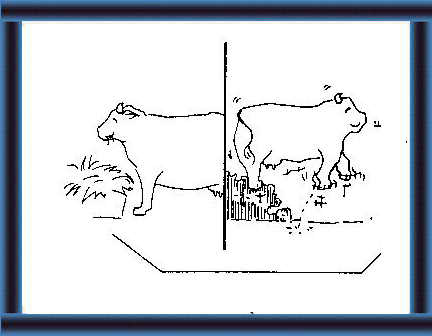 |
45 TDN tells you how much energy your animals can get from a feed. |
 |
46 If your feed has 60 % TDN your animals can get 600 g TDN (of energy) from 1 kg of feed. |
 |
Digestible crude protein (DCP)
47 DCP tells you how much protein your animals can get from feed. |
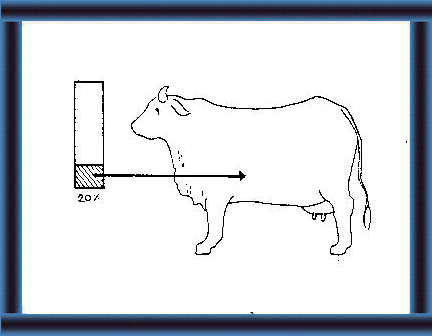 |
48 If your feed has 20 % DCP your
animals can get 200 g of protein from 1 kg of feed.
|
page 21
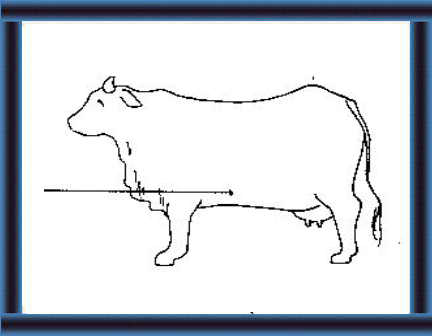 |
Minerals
49 Important minerals are necessary. If your feed has 1 % phosphorous your animals can digest 10 g of phosphorous in 1 kg of feed. |
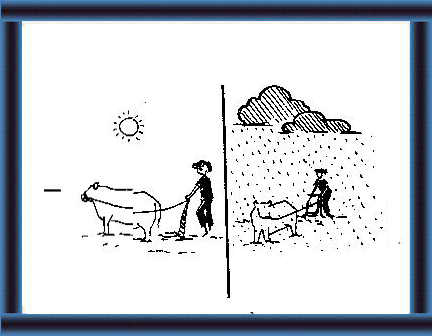 |
Dry matter content (DM)
50 The DM of feeds is very different in: - different types of feed - stage of harvesting or growth - type of processing - climate. |
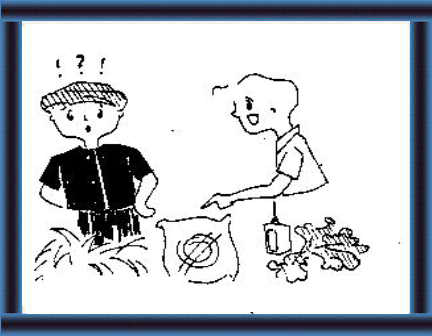 |
51 Check carefully if the TDN, DCP and
mineral values are percentages of the DM or the total feed.
Consult your extension worker . |
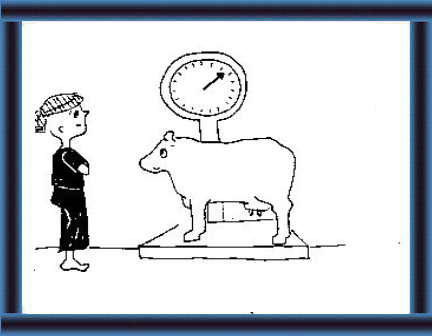 |
How can you find the feed intake of your animals?
52 Feed intake (DM of feed) A simple way is to take:
|
page 22
| Feed intake
(52-61)
A feed has two main components: water and dry matter. It is the DM component that supplies the nutrients. Therefore, feed intake refers to dry matter intake (DMI). The approximate DMI of cattle can be computed in different ways: - 3 % of the body weight
The estimated DMI based on the last method of computation is given in Table 1 in Annex 2. The DMI depends on many factors. Among them are availability of water, type and quality of roughage, feeding frequency, amount of concentrates given, digestibility of the feeds, condition of the animal, weather conditions etc. Roughages are very important in the diet of ruminants because they supply the crude fibre which is necessary for proper functioning of the rumen. Optimally 18-20 % of the DMI has to be crude fibre. If the crude fibre content is too low, milk fat content in the milk can fall. On the other hand, if the crude fibre content is too high, the animal will not be able to consume sufficient DM. Thus it will not receive all its requirements of energy and proteins, and the milk yield will drop. |
page 23
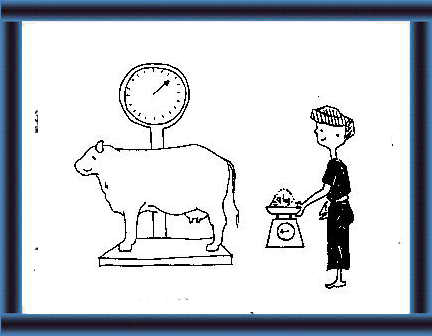 |
53 So for a 300 kg cow, the feed intake is:
300 kg x 3 = 9 kg
|
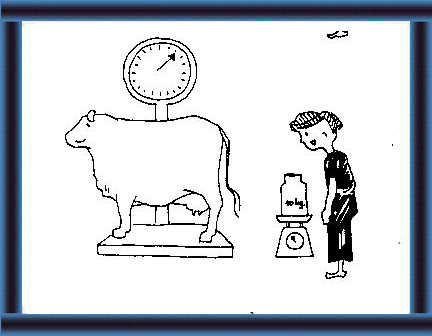 |
54 To allow for
milk yield,
you can estimate the feed intake as:
6 kg + body weight + milk yield
|
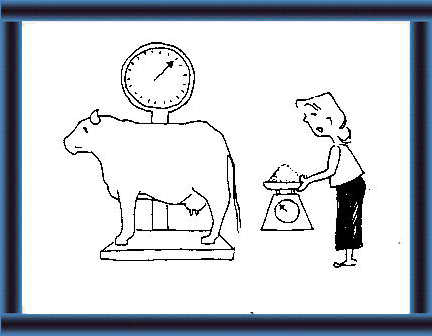 |
55 So, for
300 kg cow 10 kg milk yield, feed intake is: 6 kg + 300 kg + 10 kg = 11.0
kg
|
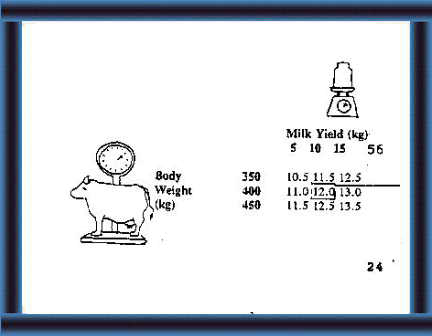 |
56 Ask your extension worker
to show you a table.
Feed intake for a 400 kg cow with a milk yield
of 10 kg.
|
page 24
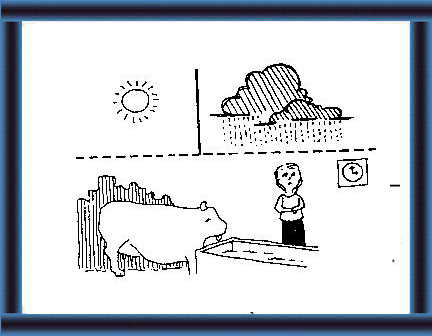 |
57 The feed intake depends on:
- climate
|
 |
58
- the type and quality of roughages - the amount of concentrates - how digestible the feeds are etc. |
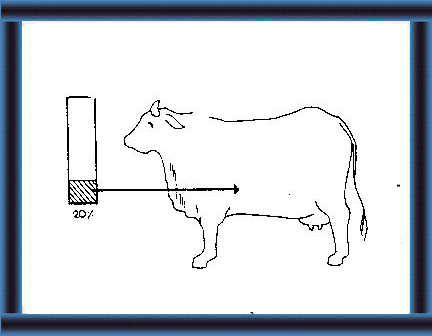 |
59 At least 20 % of the
feed intake should be crude fibre for good digestion.
Roughages are important because they provide crude fibre. |
 |
60 Too little crude fibre content leads
to low milk fat content.
Too high crude fibre content leads to poor
feed intake and low milk yields.
|
page 25
| Water intake
(62-64)
Water is an essential requirement for the proper functioning of animals. Some of its main actions relate to: digestion and absorption of food; transport of nutrients throughout the body and metabolic wastes to the excretory organs (being a component of all body fluids); control of body temperature (conductive and evaporative cooling) and milk secretion (being a component of the milk). Animals obtain their water requirements from three main sources: - water in the food; - water consumed voluntarily; - water formed in metabolic activities of the body. As a rule of thumb, lactating cows require 4 to 6 litres of water per kg DM consumed. Higher amounts may be required in hot tropical conditions. The ideal is to allow dairy cattle and buffalo continuous access to drinking water. Where this is not possible, they should be offered as much as they can drink, at least twice a day. |
page 26
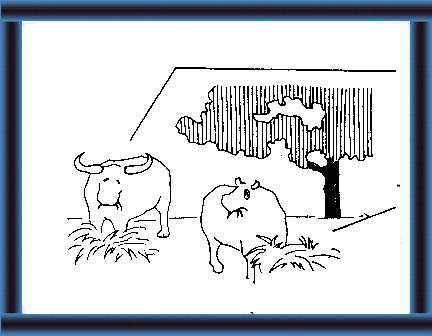 |
61 Buffaloes can make use of coarse feeds better than cattle. |
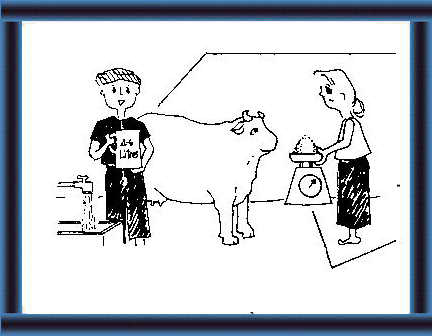 |
Water intake
62 You can estimate that lactating cows need 4-6 l of water for each 1 kg of feed intake (DM). |
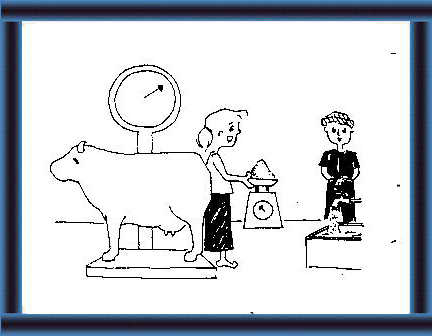 |
63 So the 300 kg cow with a 10 kg milk yield
and 10 kg feed intake needs:
11 kg x 6 l = 66 l (feed intake) (water) |
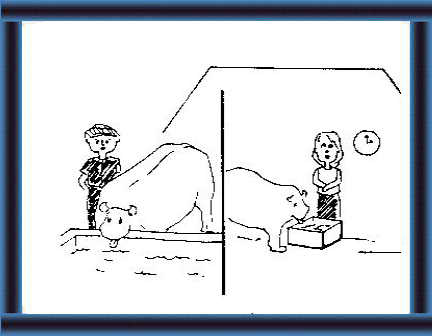 |
64 If possible, give your animals
free
access to water.
If not, make sure they have enough to drink
at
least twice a day.
|
page 27
| Nutrient
requirements (65-73)
The requirements of the different nutrients vary depending on several factors. Basically they can be considered as maintenance requirements and production requirements. Compare the nutrient requirements of dairy cattle/buffalo to the fuel requirements of a motorcycle. Maintenance requirement is the requirement of nutrients to just maintain the animal without losing body weight. It depends on the size of the animal, which is usually measured in terms of its weight. (If a motorcycle is started without being put to any use, some fuel and lubricating oils will be used up. In a similar manner, the living animal also uses up mainly energy and proteins and also small quantities of other nutrients, just to maintain the body mechanisms functioning.) Production requirement is the requirement of nutrients for the various production functions. The different production functions require varying amounts of nutrients. - A young animal that is still growing requires more nutrients in addition to its requirement for maintenance. (A motorcycle requires more fuel and oil to be driven from one place to another.) - A pregnant animal requires more nutrients for the growth of its calf (foetus) in addition to its own maintenance re-quirement. A young growing heifer which is also pregnant requires nutrients for maintenance, its own growth and the growth of its calf. (Compare to a motorcycle - using its engine power to move from one place to another, with an additional passenger.) |
page 28
How can you find the nutrient requirements of your animals?
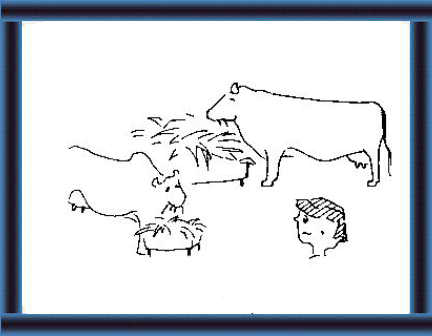 |
Maintenance requirement
65 This is the amount of nutrients an animal needs when it is not growing or producing. It depends on the weight. |
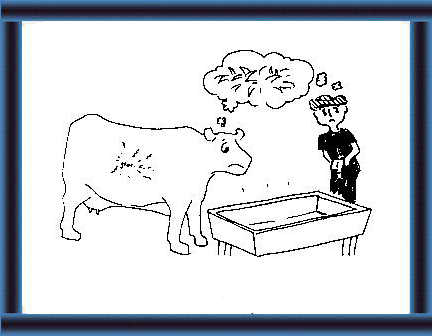 |
Production requirement
66 Your animal needs more
than the maintenance requirement to produce
|
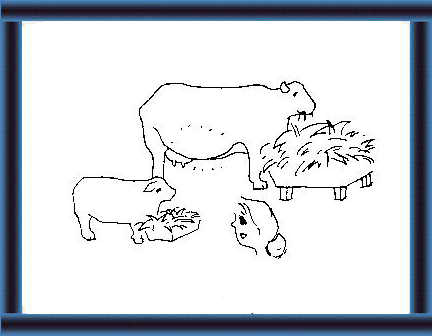 |
67 Your animal needs extra nutrients
for:
- growth - pregnancy |
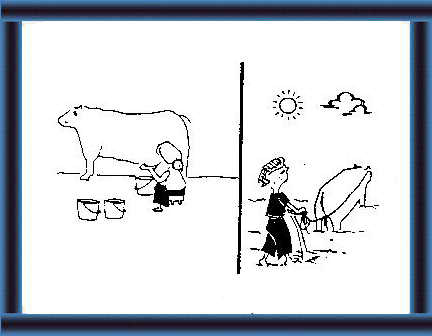 |
68
- milk production - work.
|
page 29
| - A lactating animal requires
more nutrients for milk production in addition to its maintenance requirement.
Thus a cow that starts lactating before completing its own growth requires
nutrients for its maintenance, own growth and milk production.
(Compare to a motorcycle - using its engine power moving from one place to another, up a hill.) - An animal that is used for work requires more nutrients for work in addition to its maintenance requirement. (Compare to a motorcycle used to pull a carriage.) The nutrient requirements of dairy cattle have been worked out under experimental conditions. (See Tables 2 and 3 in Annex 2) |
page 30
70 Growing heifers (large breeds)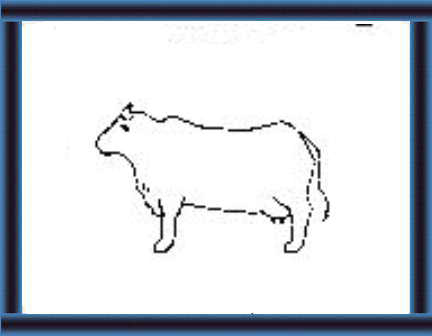
100 750 370 260 2.0 10.9 8.4 150 750 435 295 2.7 15.0 12.0 200 750 500 330 3.4 18.0 14.0 |
71 Maintenance of mature
lactating cows
350 468 220 2.8 14.0 11.0 400 521 245 3.1 17.0 13.0 450 585 275 3.4 18.0 14.0 |
| 72 Maintenance and pregnancy
(last 2 months of gestation) 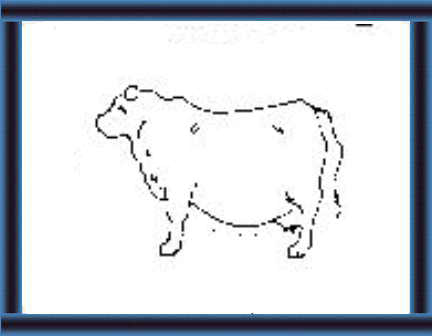
500 780 430 4.8 29.0 22.0 550 850 465 5.2 31.0 24.0 600 910 500 5.6 34.0 26.0 |
| 73 Milk production (nutrients/kg
milk)
% Fat 4.0 78 51 0.330 2.7 2.0 4.5 82 54 0.355 2.8 2.1 5.0
86
56
0.380
2.9
2.2
|
page 31
| Balanced
rations (74)
Remember that all nutrients have to be supplied in required amounts. If there is a deficiency in the supply of any one nutrient, the animal will be unable to utilize adequately the other nutrients supplied. The principal of the minimum bucket applies. The deficient nutrient limits the utilization of the others. Therefore, balanced rations should be supplied in adequate amounts. The extension officer should: - develop the skills to formulate suitable rations incorporating available feeds for the dairy cattle/buffalo in the local area, using the standard nutrient requirements and nutritive values of various feeds as guidelines; and - advise farmers on feeding these rations to their cattle and buffalo. Ration calculation (75-83) An example is worked out below to show how to do a ration calculation. The example is simplified for easy understanding of the principles. The field situation can be more difficult and variable. To get a clearer picture of the field situation, a ration calcu-lation worksheet can be used. (See extension materials). Step 1 - Obtain general data - age and body weight of cow
Assume step 1 results in the following information: Crossbred cow; age 4 years and body weight 400 kg; daily milk yield 10 kg with 5 % butter fat; 2nd month of lactation; not pregnant and lactation number 2: Feed available Nutritive value
DM TDN
DCP
Fresh grass
20
60
4
|
page 32
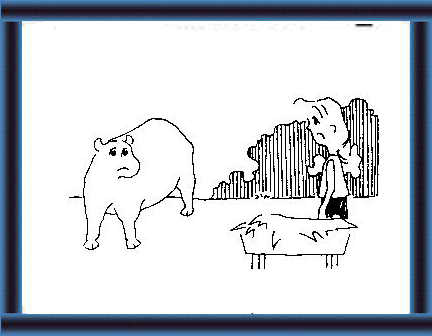 |
Balanced rations
74 Your animals need balanced rations. If one nutrient is lacking, they cannot make good use of the other nutrients, even if the other nutrients are sufficient. |
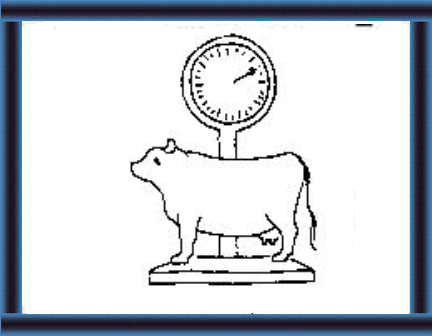 |
How can you calculate rations?
75 A: INFORMATION REQUIRED You must collect information for your worksheet (See A on next page) e.g.: Your crossbred cow
|
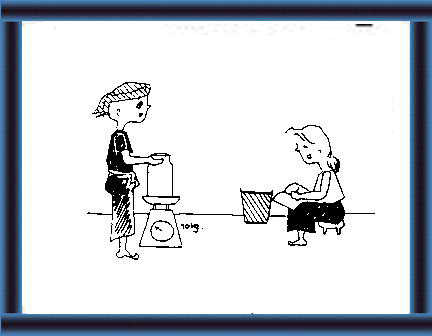 |
76 Your milk
Milk yield: 10 kg/day Butter fat: 5 % |
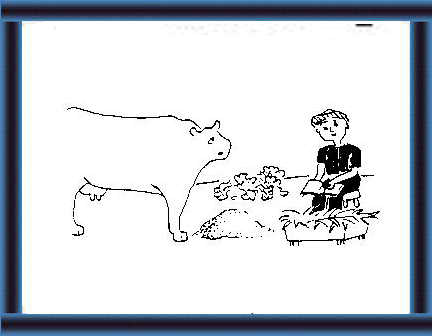 |
77 Your Feeds
Availability
Fresh grass 20 60 4 Concentrate 90
70
18
|
|
RATION CALCULATION WORKSHEET
Notes: 1 Desired weight gain: add 20 % to the maintenance allowance during the first lactation and 10 % during the second lactation. 2 At least 25% of DMI must come from forage to protect milk quality. |
||||||||||
| Step 2
- Fill in part A of ration calculation sheet
Step 3 - Calculate the requirements of the cow (part B of sheet) as follows: Animal's requirements DM (kg) TDN (kg) DCP (kg) Maintenance
-
3,1001
2451
(1) The relevant values for cow of 400 kg body weight from Table 3. (2) 10 % of maintenance requirement
as the cow is in second
(3) The relevant values against 5 % fat in Table 3 multiplied by 10. (4) Given value for 400 kg cow
with 10 kg milk yield per day. See #
56
|
| B:
ANIMAL REQUIREMENTS
78 You must calculate the requirements of your cow:
Note:
10 10 TDN = 0.380 kg x 1,000 g x 10 = 3,800 g DCP = 56 g x 10 = 560 g 4 See the table in 56 above - DM for a 400 kg cow with a milk yield of 10 kg/day. |
| Step 4
- Calculate the amount of nutrients that can be supplied by roughages
In this example, only one roughage is considered. In the field various combinations of roughages may have to be considered. In any event, the availabilities of roughages will vary during different seasons. Therefore, fresh computations have to be done when the availability changes. If the total DM requirement of 12 kg is supplied with the available fresh grass, the nutrients supplied are: TDN (600 x 12)
= 7,200 g
Therefore, there is a shortfall of (7,210 - 7,200 =) 10 TDN and (830 - 480 =) 350 g DCP. It is also unlikely that the cow will consume (100/20 x 12 =) 60 kg of the fresh grass to obtain 12 kg of DM from grass alone, because of the bulk and the low palatability. Therefore, it would be necessary to offer a concentrate to meet the shortfall. Step 5 - Calculate the amount of nutrients that have to be supplied from concentrates In this particular example, it is assumed that the cow will consume only about 9 kg DM of grass i.e. (100/20 x 9 =) 45 kg of fresh grass. DM (kg) TDN (kg) DCP (kg) Total requirement
12
7,210
830
By supplying 3 kg DM of the concentrate containing 70 % TDN and 18 % DCP, 2,100 g TDN and 540 g DCP will be available to the cow, thereby meeting the shortfall in the nutrients. If the concentrate mixture contained 90 % DM, the amount of concentrate mixture to be supplied is (100/90 x 3 =) 3.3 kg. |
|
C: NUTRIENT CONTENT OF FEEDS AVAILABLE You must calculate the amount of nutrient available from:
NUTRIENT REQUIREMENTS - NUTRIENTS AVAILABLE = SHORTFALL TDN: 7,210 g - 7,200 g = 10 g TDN DCP: 830 g - 480 g = 350 g DCP You must
offer your animals concentrates to make up for this shortfall.
|
Concentrates
 |
81 If your cow only consumes 45 kg fresh grass (9 kg DM) |
|
DM (kg)
TDN (g)
DCP (g)
Your cow's
12
7,210
830
Available
in
9 kg
5,400
360
|
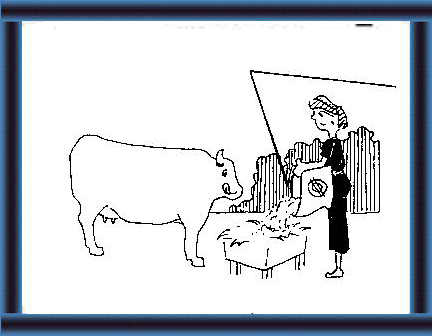 |
82 If you use this concentrate:
DM (kg) TDN (70%) DCP (18%) 1 kg 700 g 180 g 3 kg 2,100 g 540 g 3 kg DM is enough to meet the shortfall. |
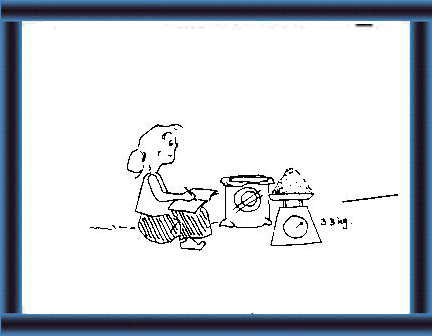 |
83 If the concentrate is 90 % DM, you
need
3 kg x 100 = 3.3 kg concentrate
If your cow eats less than 45 kg fresh grass,
then you need more concentrates.
|
page 39
| Concentrate
mixtures (84-87)
Sometimes it is necessary to make concentrate mixture to meet particular needs. If: (i) - in the above example (Step 5), the shortfall from the fresh grass was 1,800 g TDN and 400 g DCP i.e. the grass contained more DCP; (ii) - in the concentrate mixture that was available (i.e. concentrate mixture 1) each kg DM contained 700 g TDN and 180 g DCP i.e. 180 g DCP per 700 g TDN or (180/170 x 1,000 =) 257 g DCP per kg TDN; (iii) - the requirement would be 1,800 g TDN and 400 g DCP i.e. (400/1,800 x 1,000 =) 222 g DCP per kg TDN. The requirement, therefore, is for a mixture with less DCP than the one available. If the available mixture is fed, there will be a wastage of DCP, when adequate TDN is supplied. This mixture has to be balanced with another feedstuff with less DCP. Suppose rice bran with DM 90 %, TDN 50 % and DCP 9.0 % is available. It has 90 g DCP per 500 g TDN or (90/500 x 1,000 =) 180 g DCP per kg TDN. |
page 40
Concentrate mixes
 |
84 The concentrate in 82 above
provides 700 g TDN and 180 g DCP for each 1 kg DM.
So 1 kg TDN provides 180 x 1,000 = 257 g DCP/kg TDN
|
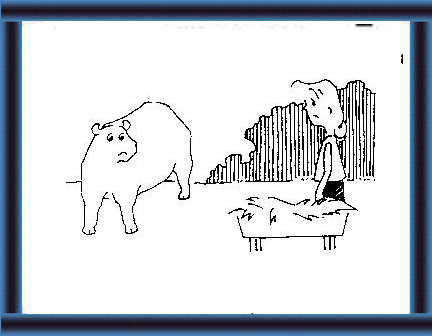 |
85 This farmer has a shortfall of:
TDN DCP 1,800 g 400 g from the roughage available to him. So the requirement is: 400 x 1,000 = 222 g DCP/kg TDN
|
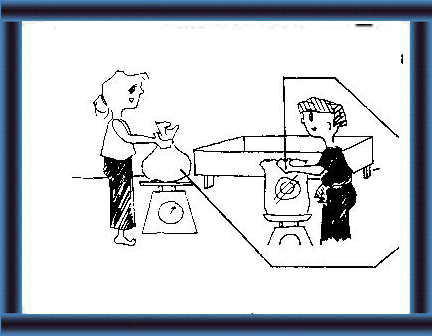 |
86 If he feeds the concentrate in 82, when the
animal has enough TDN, there is a wastage of DCP.
He can mix the concentrate with a feed which has less DCP e.g. rice bran with the following composition: |
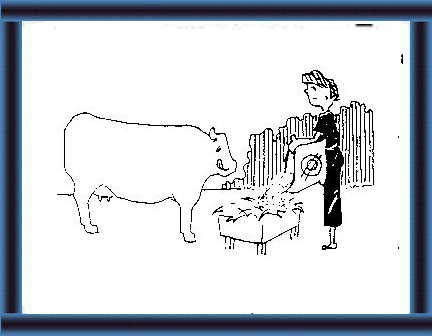 |
87
DM TDN
DCP
So the rice bran has: 90 g DCP/500 g TDN or 90 x 1,000 = 180 g DCP/kg TDN
|
page 41
By using Pearson's Square,
the composition of the new ration (i.e. concentrate mixture II) can be
calculated.
3 kg DM of concentrate mixture II would contain 1,650 g DM from concentrate mixture I and 1,350 g of DM from rice bran. The nutrients supplied by 3 kg DM of the concentrate mixture II are as follows: Feed
Quantity
TDN
DCP
Concentrate
1,650 700 x 1,650
= 1,155 180 x 1,650
= 297
Rice bran
1,350 500 x 1,350
= 675 90 x 1,350
=121
This shows that 3 kg DM which is equal to (100/90 x 3 kg =) 3.3 kg by weight of concentrate mixture II are adequate to meet the shortfall of TDN and DCP supply from fresh grass. |
page 42
He can use
Pearson's Square to calculate the composition of the new concentrate
mix.
|
 |
So for a concentrate mix
with 222 g DCP/kg TDN, mix: 35 x 100 = 45% DM rice bran with
42 x 100 = 55% DM concentrate
(The DM for rice bran and concentrates are both
given as 90%. Adjust if the DM's are different).
|
| Feed
DM (g)
TDN (g)
DCP (g)
Concentrate
55 x 3,000 = 1,650 700
x 1,650= 1,155 180 x 1,650
= 297
Rice
bran 45 x
3,000 = 1,350 500
x 1,350 = 675 90 x 1,350
= 121
So 3 kg DM
or 100 x 3 kg = 3.3 kg of concentrate mix is enough to meet the
|
| Notes
(88-91)
- Ration calculations should be used only as a guideline. The nutritive value and the palatability of the same feedstuff can vary widely depending on a large number of factors. There are differences among individual animals, too, with regard to feed utilization. However, feeding the animals based on a scientific method is definitely better than blindly offering whatever is available. - Even in this particular example, if the cow does not eat 45 kg of fresh grass per day or if this quantity is not available, more concentrates will have to be offered to meet the shortfall in the nutrient supply. - It is generally accepted that 1 kg of a good concentrate mixture supports the production of 2 kg of milk. However, when the amount of concentrates offered is increased, the amount of milk produced from each kg of concentrates de-creases (law of diminishing returns). - This is particularly important when the difference between the prices of concentrates and milk is very small (or if the concentrates cost more than milk). On the other hand, if the animals do not receive sufficient nutrients, apart from low yields of milk other problems such as long calving intervals can arise due to the cows not conceiving regular-ly. - Apart from the energy and protein supplies, mineral requirements also have to be supplied. A suitable mineral mixture should be provided either with the concentrates or as a separate lick. |
page 44
| Annex 1
Feeding dairy buffaloes
The countries where buffaloes are raised for both milk production and as draught animals have large animal populations. The feeding of stock is not always given proper attention. In India and Pakistan, buffaloes are raised mostly on crop residues. Part of the requirements are met through grazing stubble, canal banks etc. Green fodder is also produced and fed under the cut and carry system. The fodder is grown to such a stage of maturity that it provides lots of bulk but lacks nutrients. Rice and wheat straw are fed in plenty since year round supply of green fodder is not ensured. Although buffaloes have shown excellent abilities for using crop residues, for satisfactory milk yield, an adequate fodder supply is essential during all stages of raising. For lactating animals adequate nutrients must be provided both for body maintenance and production. In good producers even ample green fodder may not fulfil all the requirements. Hence feed supplements/concentrates are required. After parturition even poorly fed buffaloes tend to maintain milk production for a few days at the expense of their body. This leads to poor production and shorter lactations. In India and Pakistan and several other countries many village buffaloes are low producers because their requirements are not met. Much higher milk production potential has been demonstrated in well managed herds which produce over 3,000 litres of milk per lactation. Good buffaloes produce 12-15 litres of milk per day and on average between 5-10 litres of milk per day. Higher producing animals must be provided with ample nutrients to maintain production as well as general health. |
page 45
| Buffalo can consume a variety
of coarse fodders. For milk production 1 kg of concentrate is fed
for 2 to 2.5 litres of milk produced. A ration could consist of green
fodder + wheat straw + concentrate. Depending on the dry matter and
TDN the green fodder, straw and concentrates must be adjusted.
60 to 70 kg of succulent fodders (Egyptian clover etc) would be fed to a buffalo weighing 500 kg. A single source of fodder may be deficient in nutrients such as legumes and require phosphorus supplementation. When a large quantity of wheat or rice straw is fed, Ca and P deficiency occurs. For fodders with less maize, millet etc and high dry matter the quantity should be adjusted to between 20 to 30 kg per day along with some straw and concentrate. Avoid feeding coarse fodders to lactating animals. Silage or hay can also be efficiently used if available. Feeding pregnant buffaloes The ideal calving interval is 13-14 months. Owing to feeding and management practices, however, the animals tend to have a long calving interval with a long dry period. Since many pregnant buffaloes will not be producing any milk during the last part of pregnancy, these are not properly fed. During this period the buffalo should build up body reserves lost in early lactation. Nutrients are required for the fast growing foetus during the later stages of pregnancy. The body condition of the buffalo must be given proper attention. In addition to good fodder, 1 to 1.5 kg concentrate during the last part of pregnancy will help in attaining good foetal growth, health of buffaloes and a good start in subsequent production. |
page 46
Important
 |
88 Use these examples and calculations
as guidelines.
Consult your extension worker when planning feeds. |
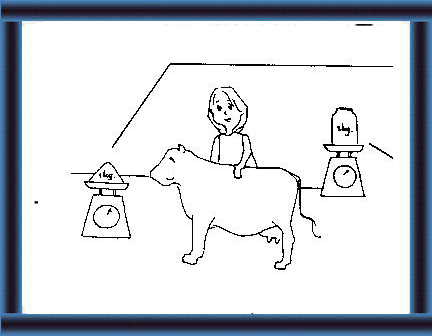 |
89 You can estimate that 1 kg of good concentrate mix supports the production of 2 kg of milk, but increasing concentrates does not increase milk production at the same rate. |
 |
90 Calculate carefully:
- giving too much concentrates wastesmoney. - giving too little concentrates may lead to low milk yields or calving intervals. |
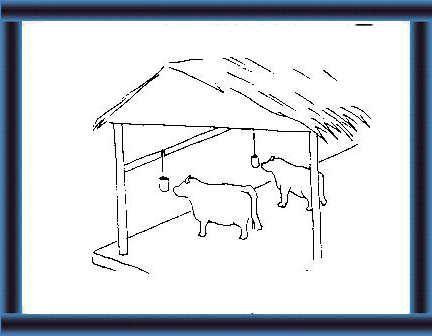 |
91 You should
meet
your animal's mineral requirements by:
- mixing with concentrates - a separate mineral lick.
|
page 47
|
page 50
|
|||||||||||
page 51
|
page 52
|
page 53
|